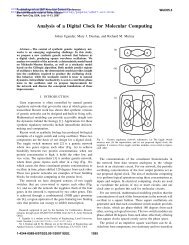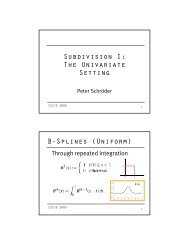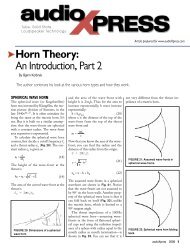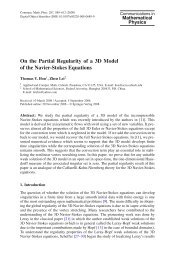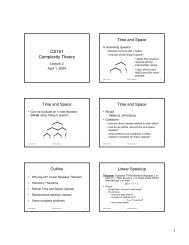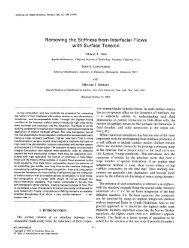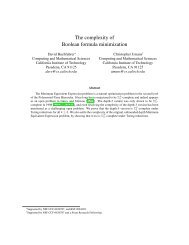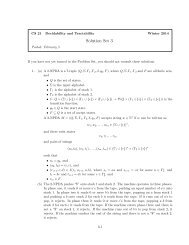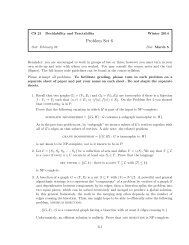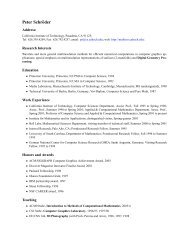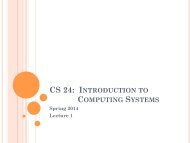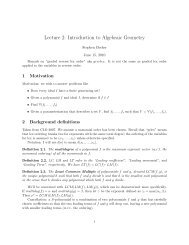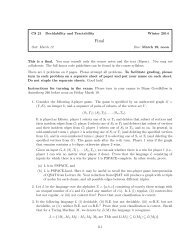From Steiner formulas for cones to concentration of intrinsic volumes
From Steiner formulas for cones to concentration of intrinsic volumes
From Steiner formulas for cones to concentration of intrinsic volumes
Create successful ePaper yourself
Turn your PDF publications into a flip-book with our unique Google optimized e-Paper software.
STEINER FORMULAS FOR CONES AND INTRINSIC VOLUMES 156.3.2. Tail behavior. Circular <strong>cones</strong> also exhibit tail behavior that matches the predictions <strong>of</strong> Corollary 4.10exactly. It takes some technical ef<strong>for</strong>t <strong>to</strong> establish this claim in detail, so we limit ourselves <strong>to</strong> a sketch <strong>of</strong> theargument. These ideas are drawn from [ALMT13, Sec. 6.2].Fix an angle 0 < α ≪ π 2 , and abbreviate q = sin2 (α). Consider the circular cone C = Circ d (α) where thedimension takes the <strong>for</strong>m d = 2(n +1) where n is a large integer. In particular, the <strong>for</strong>mula (6.2) shows that thestatistical dimension δ(C) ≈ d sin 2 (α) ≈ 2nq. It can be established that the odd <strong>intrinsic</strong> <strong>volumes</strong> <strong>of</strong> C follow abinomial distribution [Ame11, Ex. 4.4.8]:2 v 2k+1 (C) = P { Y = k} where Y = Y n ∼ BINOMIAL(n, q).As a consequence <strong>of</strong> the Gauss–Bonnet Theorem [SW08, Thm. 6.5.5], there is an interlacing result [ALMT13,Prop. 5.6] <strong>for</strong> the upper tail <strong>of</strong> V C .P { Y ≥ k } ≤ P { V C ≥ 2k } ≤ P { Y ≥ k − 1 } .Thus, accurate probability bounds <strong>for</strong> V C follow from bounds <strong>for</strong> the binomial random variable Y .Our tail inequality, Corollary 4.10, predicts that V C has subgaussian behavior <strong>for</strong> moderate deviations. Tosee that circular <strong>cones</strong> actually display this behavior, we turn <strong>to</strong> the classical limits <strong>for</strong> the binomial randomvariable Y n . The Laplace–de Moivre central limit theorem states thatP { Y n − nq ≥ t √ nq(1 − q) } → 1 − Φ(t)as n → ∞ with q fixed.Here, Φ denotes the distribution function <strong>of</strong> a standard normal variable. When q is small and n is large, wecan invoke the approximation δ(C) ≈ 2nq and a tail bound <strong>for</strong> the normal distribution <strong>to</strong> obtainP { V C − δ(C) ≥ λ √ δ(C) } ≈ P { V C − 2nq ≥ λ √ 2nq(1 − q) } ≈ P { Y n − nq ≥ (2 −1/2 λ) √ nq(1 − q) } ≈ e −λ2 /4 .This expression matches the behavior expressed in the weaker tail bound (4.14). In other words, we see thatthe <strong>intrinsic</strong> <strong>volumes</strong> <strong>of</strong> a small circular cone have subgaussian <strong>concentration</strong> <strong>for</strong> moderate deviations, withvariance approximately 2δ(C).Corollary 4.10 also predicts that V C has Poisson tails <strong>for</strong> very large deviations. Vanishingly small circular<strong>cones</strong> display this behavior. Suppose that q = q n = b/n <strong>for</strong> a large constant b. The approximation δ(C) ≈ 2band Chern<strong>of</strong>f’s bound <strong>for</strong> the tail <strong>of</strong> a binomial random variable <strong>to</strong>gether giveP { V C − δ(C) ≥ λδ(C) } ≈ P { V C − 2b ≥ 2λb } ≈ P { Y n − b ≥ λb } ≈ e b (λ−(1+λ)log(1+λ)) .After a change <strong>of</strong> variables, this <strong>for</strong>mula coincides with the tail bound (4.6). The Chern<strong>of</strong>f bound is quiteaccurate in this regime, so we see that (4.6) is saturated by vanishingly small circular <strong>cones</strong> in high dimensions.6.4. Summary <strong>of</strong> calculations. We conclude this section with an overview <strong>of</strong> the statistical dimension andvariance calculations. See Table 6.1 <strong>for</strong> this material. Observe that the ratio <strong>of</strong> the variance Var[V C ] <strong>to</strong> thestatistical dimension δ(C) can range from zero <strong>to</strong> two. A subspace L k with dimension k shows that the lowerbound is achievable across the entire range <strong>of</strong> statistical dimensions. The circular <strong>cones</strong> Circ d (α) show thatthe upper bound is saturated by <strong>cones</strong> whose statistical dimension is small. Amelunxen has conjectured thatsomewhat tighter bounds are possible when δ(C) ≈ 1 2d, but this remains <strong>to</strong> be established.7. BACKGROUND ON CONIC GEOMETRYThis section summarizes the foundational material that we require <strong>to</strong> establish the master <strong>Steiner</strong> <strong>for</strong>mula.We provide sketches or references in lieu <strong>of</strong> pro<strong>of</strong>s <strong>to</strong> keep the presentation lean. Most <strong>of</strong> the material here isdrawn from the books [Roc70, RW98, Bar02, SW08].7.1. Basics. We work in the Euclidean space R d . This space is equipped with the Euclidean inner product〈·, ·〉, the associated norm ‖·‖, and the norm <strong>to</strong>pology. We write 0 or 0 d <strong>for</strong> the origin <strong>of</strong> R d .The linear hull lin(K ) <strong>of</strong> a convex set K ⊂ R d is the intersection <strong>of</strong> all subspaces that contain K . The relativeinterior relint(K ) is the interior with respect <strong>to</strong> the relative <strong>to</strong>pology induced by R d on the linear hull lin(K ).We define the distance function dist 2 (x,K ) := inf { ‖x − y‖ 2 : y ∈ K } .We write P <strong>for</strong> the probability <strong>of</strong> an event and E <strong>for</strong> the expectation opera<strong>to</strong>r. The symbol ∼ denotesequality <strong>of</strong> distribution. We reserve the letter g <strong>for</strong> a standard normal vec<strong>to</strong>r, and θ denotes a vec<strong>to</strong>r uni<strong>for</strong>mlydistributed on the sphere. The dimensions are determined by context.



